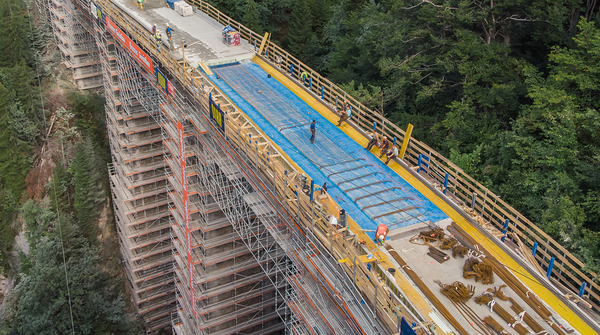Services
Local construction supervision for master builder works for the renewal of the railway tracks on the Schmiedtobel viaduct:
- Local construction supervision
- Contract management
- Construction management
Facts & Figures
- Company
- AEP Planung und Beratung GmbH
- Completion
- 2018
- Area of expertise
- Infrastructure + Civil Engineering
- Construction style
- Rehabilitation
- Construction type
- Railway bed + tracks
- Work carried out
- Construction site supervision, contract management, construction management
- Client
- ÖBB-Infrastruktur AG, 1020 Wien
Project description
In order to meet the requirements of rail-bound passenger and freight transport at a planned speed of 80 km/h, rehabilitation work was carried out on the Schmiedtobel Viaduct between Dalaas and Hintergasse in 2018.
Without the rehabilitation of the viaduct, trains would have had to cross the viaduct at much lower speeds due to the significant static and dynamic effects in order to prevent deterioration of the structure of the ageing viaduct. The viaduct – built during the construction of the Arlberg line in the 1880s – was repeatedly subjected to minor repairs and refurbishments up to 2018.
The Schmiedtobel Viaduct is a single-track bridge support structure located on the Innsbruck-Bludenz line from km 122,587 to km 122,728 and was only accessible by rail or on foot from the S16 Arlberg motorway via a holloway before work began.
In preparation for the work, a forestry road was extended to a plateau south of the railway on the eastern side of the viaduct. This forestry road served as a traffic route and was used to transport all required materials and work equipment to and from the site. The forestry road will also remain available for future inspection and maintenance work.
The construction project is essentially divided into the following work areas:
- Construction of the access road including clearing the planned route of the forest road and the storage area
- Set up the construction site using a temporary material ropeway
- Manufacture all necessary access points for the scaffolding work
- Erect scaffolding on the entire supporting structure for the rehabilitation work on the pillars and arches
- Reinforcement of the arches by means of transverse prestressing
- Temporary storage of the edge beams and partially precast elements manufactured in advance at the precast concrete plant
- Partial removal of the existing bridge support structure by cutting the upper rows of stones
- Superstructure work (removal of the rails, sleepers as track sections)
- Construction of the new bridge support structure using in-situ concrete construction during the 17-day closure of the line including all sealing work, application of the protective concrete, installation of the new edge beams and construction of the new track bed with railway tracks
- Installation of new poles and the new overhead line
- Installation work on the railing
- Restoration of the joints in the existing structure using shotcrete
The meticulous preparation and coordination of the main construction measures during the 17-day line closure in mid-August 2018 proved to be a particular challenge for everyone involved in the project. Thanks to intensive and fruitful coordination meetings, the construction project was completed as planned and within the allotted time.
